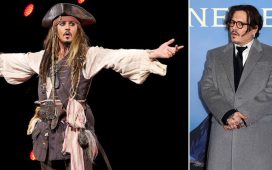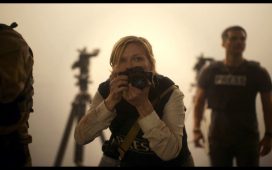
I Lost My Body promises to be one of the most visually unique and original movies of the year. Filmmaker Jérémy Clapin adapted the book “Happy Hand” by Guillaume Laurant (Amélie) to bring to life the story of a disembodied hand searching for its missing body. And while that journey is compelling enough on the page, it’s Clapin’s mastery of animated storytelling that makes I Lost My Body something truly special.
I had a chance to chat with Clapin about adapting the story, the particular challenges posed by animating a story from the perspective of a severed hand, and the importance that sound and music played into both the narrative and the audience’s experience. Also, while it wasn’t a fluke that I Lost My Body became the first animated film to win the Nespresso Grand Prize at Cannes, we also talked about the movie’s Oscar chances and his reaction to all the attention its receiving after years of the creative team’s hard work.
Be sure to read my review for more, and add I Lost My Body to your Netflix watchlist since it’s available to stream now.
First of all, congratulations on winning the Nespresso Grand Prize at Cannes, the first animated film to do so. What was that moment like for you?
Jérémy Clapin: That week in Cannes was the first time the film got exposure. Me, my producer and team had spent a lot of time doing the film. During all the production we were working hard quite alone without a lot of support. So, when the film came to life in Cannes with such great reception from the audience, the contrast was huge. People were talking about the film, about the actors, it was only about cinema purposes not about the animation techniques. That means a real success for us who wanted to be considered as filmmakers before all.
And when at the end of the week you get the grand prize (first time for an animated film), you feel proud for you and your team and also you feel that the times are changing concerning the animation. It is a real exciting period for animation.
How did you come across Guillaume Laurant’s “Happy Hand” and what was it about the story that made you want to adapt it into a feature film?
Clapin: In 2012 I met my producer Marc du Pontavice around the book “Happy Hand” from Guillaume Laurant. He wanted me to adapt the book and to do it into an animated feature film.
I read the book. I though the concept was bizarre and unique, so I loved it! Thanks to Guillaume for being different and bizarre! I was immediately captivated by the absurd but powerful aspect of the concept of this severed hand, coming to life and determined to reach its body. It was a reverse perception of lack. It was about a hand who misses the body and not the opposite. It was about the feeling to not feel complete. This irruption of the hand as a fantastic element into reality allows you to see, to experiment, a story in a very unique and new angle and it puts light on thematics not easy to put on the table without this. This is for me the best justification and the purpose of the fantastic cinema.
I remember after reading the book that I was looking at my hand, trying to figure out what it could tell about me. I knew that adapting the novel would be a hard challenge, I knew we won’t have any chance to get a TV channel or to get funding so I said,” Yes! I’m your man! Let’s go for 7 years hard working on it!”
Pardon the pun, but did you and Guillaume flesh out the novel’s story for the movie’s script? Is the movie more of an adaptation or a translation?
Clapin: The movie is quite far from the book now. As any adaptation, you have to betray the book. It took us time to get rid of the story, and I remember one summer I decided to start from scratch, from the unique concept which brings me the hand’s point of view. More than a story, I wanted this film to be an experience for the audience. I wanted the audience to experiment life as a hand, as a little part of something bigger. A journey with and inside a hand, both physical, in memory, and sensorial. So I started to rebuild the story around that, around the hand, and to bring my own universe. I had to reinvent all the characters, the sensibility and path of Naoufel. As the hand has a tactile relationship to the world, Naoufel has got a sensorial approach to the world by recording sounds, which was not in the book. It [led] me to set this intercom sequence when Naoufel falls in love with Gabrielle. Her voice reconnects him to the world.
Also because the film was about destiny, I wanted to evoke its presence all along the film through the irruption of the fly, it was helpful to connect all the pieces together. Life is made by details which, [when] put next to each other’s, tells something bigger.
I Lost My Body feels like a story that’s perfectly suited to animation over live-action, especially concerning the hand’s journey. Did you have any particular challenges when it came to animating the hand’s story?
Clapin: Of course, we had to focus to not be too scary or too funny but also to get away from any cinematic past history experience about a severed hand (as Addams Family for example).
Its moving vocabulary has to be natural, subtle. As a new animal kind coming to life, we had to be creative. The hand has the possibility to go on their knees, to sit on a window, etc. It was only about how to express emotions, how to generate empathy to this character.
But the challenge was not only how to animate the hand. We had to trust its sensoriality. The film directing has to be sensorial too. It was mostly how to frame the hand, how to put the camera next to the floor, to discover the world as the hand does, with the tips of the finger, to see and hear the word as the hand does. Even the editing of the film has to participate to feel this sensation of being a little piece of something bigger.
I love how the hand’s perspective plays out like an action movie with daring escapes, thrilling fight sequences, and even tender moments, all on a much smaller scale than we’re used to seeing. Do you have a particular sequence with the hand that was your favorite?
Clapin: I like the part when the hand escapes into a ravioli box, it starts to be a bit funny and then after falling into the escalator on the rails we have this very brutal meeting with rats. I like to contrast the audience feeling. To create a kind of uncomfortable, insecurity for the audience … as it is for the hand.
On the other hand—again, please forgive the pun—Naoufel’s story is touching, sometimes troubling, often awkward, but ultimately endearing and inspiring. Do you have a favorite moment from Naoufel’s journey?
Clapin: Probably the intercom sequence. It is the really starting point of all the future actions of Naoufel. This is when Naoufel decides to get his destiny back. I wanted, through this sequence and this unexpected happy meeting / accident of life, to surprise both Naoufel and the audience. Nobody is prepared to have a turning point of your life talking to an intercom.
I love how the visuals—black-and-white vs color—anchor the viewer in either the past or the present; it felt similar to the convention used in Memento. Were there any other visual motifs you used to set young Naoufel apart from his young adult self?
Clapin: The use of the black and white was efficient but it is also about light, depth of field and framing. The Morocco period, which is the childhood of Naoufel, has to be as a lost paradise. It has to be luminous, joyful, full of promise. When we are traveling through the flashback it has to be sensorial, so as a director you need to be more evocative, so less narrative or didactic.
Music and sound is every bit as important to I Lost My Body as the visuals are, and they’re essential to Naoufel’s journey and sense of self, too. Can you talk about the work of both composer Dan Levy and sound designers Coste Anne-Sophie and Manuel Drouglazet?
Clapin: The film is a journey through the point of view of a hand. The sound has to participate as equal as the camera does to exalt this new perception of life. The hand is not experiencing the town how we do; life is much more intense through the perception of the hand. Manuel and Anne-Sophie did a great job. The sound design during the hand part doesn’t has to refer with any realism or naturalistic sound. It has to be more organic, tense. We have to feel the pulsation of blood and urgency. Also we had to invent and create a common language between sound design and music, something which allowed us to make transition between both.
As a director, I’m always very focus on music in the film. I wanted the music to raise all this daily urban context to something mystical, cosmic. When it came time to find a good composer, you have to trust your instinct, your sensibility. I really liked the work of Dan Levy, his sense of melody and his both natural and electronic arrangements. So when he brought to me the first musical mood and the theme of the film, I immediately thought that the film has found its music. Meeting Dan on this project was a sign of destiny. If the film is a planet I think the Dan Levy score is its universe which makes it turn properly.
Back to awards talk for a second, I Lost My Body premieres on Netflix this week after a U.S. theatrical run. What are your hopes for an Oscar nomination and, ultimately, a win?
Clapin: Oh believe me! This film is my first feature film, I worked on it as I use to work on my shorts films, with honesty and artistic freedom. Today, I’m already very proud for the team and I. Everything happening since the release in Cannes of the film is magic. I don’t want the magic to stop now and I’m really excited to see what’s going on with the Oscar nomination. Fingers crossed.
What do you hope viewers get from watching I Lost My Body?
Clapin: I want the audience to experiment something new and strange. Today the system, the society is a bit scare about bizarre things. But me, I think bizarre is beautiful, we are all a bit strange. That is why poetry exists.
I want the film to bring them somewhere they didn’t plan to go, somewhere into their past, somewhere inside themselves.
And, of course, I want the audience to consider animation as a technique, not a genre.
I Lost My Body is streaming on Netflix now.




















